A standby generator is a backup system that automatically works during power outages. If you live in an area where blackouts are the norm and go out for hours, then you will benefit from a whole house generator. From bad weather to natural disasters, many situations can leave us with no power. Without electricity, much of our normal operations are put to a halt. Food goes bad, the internet is lost, and lots of other services are interrupted. This may present a dangerous and unpleasant situation. That said, the best whole house generator is designed to handle the power requirements for an entire home. This post explores all aspects of the best standby generators on the market. We only selected the most recommended home generators passing strict criteria. We also included a buyers guide and comparison tables that you can leaf through to see what is best for your home.
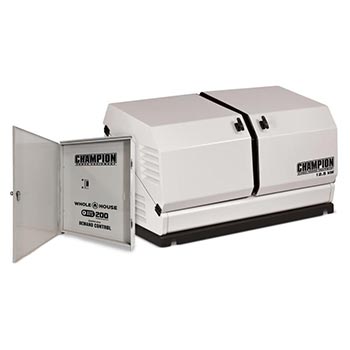
Champion 12.5kW
Liquid Propane / Natural Gas
Watt: 12,500 LPG/11,000 NG
Noise Level: 63 dBA
Computer Friendly >5 THD
Warranty: 10-Year
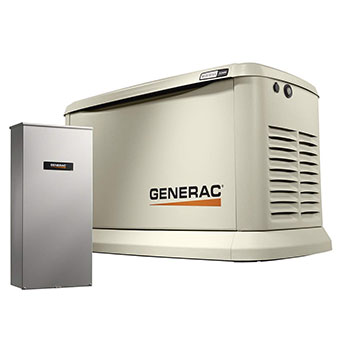
Generac 22kW
Liquid Propane / Natural Gas
Watt: 22,000 LPG/19,500 NG
Noise Level: 67 dBA
Computer Friendly >5 THD
Warranty: 5-Year
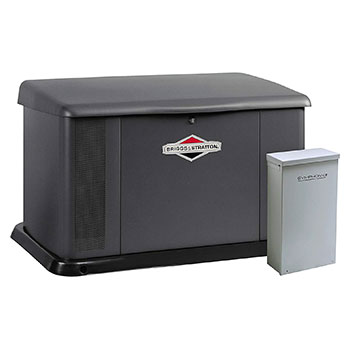
Briggs & Stratton 20kW
Liquid Propane / Natural Gas
Watt: 20,000 LPG/18,000 NG
Noise Level: 68 dBA
Computer Friendly >5 THD
Warranty: 5-Year

Briggs & Stratton 10kW
Liquid Propane / Natural Gas
Watt: 10,000 LPG/9,000 NG
Noise Level: 67 dBA
Computer Friendly >5 THD
Warranty: 5-Year
To learn more about these products, we represent our home generator reviews, guide, and more detailed comparison charts; displaying features, fuel consumption, and power capabilities.
Best Whole House Generator Reviews – Top 4
1- Champion Power Equipment 12.5kW Whole House Generator

Among the best whole house generators, the Champion Power Equipment stands out in an ergonomic and striking design. The Champion’s 12.5 kW standby generator offers your home a complete backup power system. It is fuel-efficient and operates even in extreme cold or hot weather conditions.
Features a tough and durable enclosure that is easy to remove for installation, maintenance, and service. It will cover your home’s power needs in case of emergencies, all year round.
It automatically starts when there is a power outage and turns off when the power comes back. The Champion Power Equipment 717cc OHV engine offers continuous power on either propane or natural gas. It has 12,500 watts of constant power on liquid propane and 11,000 watts on natural gas.
The 24-volt starting system delivers high-quality power with less than 5% total harmonic distortion (THD) for safely handling sensitive electronics. It is residential-friendly with a sound muffling lining and a low-tone muffler. Additionally, it offers a reasonable price tag compared to other home standby generators in the same size range.
Pros:
- One of the quietest generators in its class with an operating volume of 63 dBA. Emitting a soft purr sound ideal for home set up.
- It works from -22° F to 104° F with no warming kit required.
- A 10-year limited warranty guarantees a reliable system that will power your home in case of blackouts.
- Stationary setup with an innovative gull-wing design that provides easy access to the control panel. Giving you a full view of the onboard control system.
Cons:
- The shipped automatic transfer switch has some design issues. The ATS fuses are challenging to diagnose and replace if blown.
- The user manual has missing information regarding the emergency shut-off switch.
2- Generac 22kW Home Standby Generator

The Generac is an excellent solution for whole-house power. Automatically sensing power outages and switches on. It provides 22,000 watts on propane and 19,500 watts on natural gas. Designed to handle whole-house loads efficiently with the G-Force pressure-lubricated engine. It comes with a NEMA 3R smart transfer switch, both outdoor and indoor rated.
For an uninterrupted power supply, it can balance high wattage appliances such as the furnace, central air conditioner, sump pump, and low-wattage devices.
Features a remote monitoring option allowing you to check the generator’s status from afar. Using any of your electronic devices, smartphone or computer, you can easily access various information. There are also built-in controllers with a multilingual display to monitor the battery status and the maintenance intervals to ensure your generator is always in top condition.
With scheduled maintenance, the Generac provides automatic backup power that will protect your home from blackouts for a fair amount of time. There is also a five-year warranty on the unit.
Pros:
- It features a quiet self-test mode to easily check that everything is working smoothly.
- Boasts of True Power technology that delivers clean power with less than 5% total harmonic distortion. Clean and stable electricity that is safe for sensitive electronics.
- The Mobile Link remote monitoring and built-in Evolution Controller LCD allow for easy tracking of the maintenance and the generator’s current operating status.
- A corrosion-resistant all-aluminum enclosure with a RhinoCoat powder-coated finish. It prevents rust in all weather conditions.
Cons:
- The main problem with the Generac is the frequent maintenance, which beat the purpose of owning standby generators.
- It is loud with insufficient insulation and mufflers.
3- Briggs & Stratton 20kW Whole House Generator

Briggs and Stratton’s symphony power system is the brains behind this standby home generator. It has the ability to simultaneously deliver electricity to your washing machine, dishwasher, air conditioning unit, refrigerator, and other household appliances.
Runs on both natural gas and liquid propane gas. It puts out 20,000-watt on liquid propane and 18,000-watt on natural gas. The generator can automatically sense a blackout and automatically power up in a matter of seconds.
The package comes with an automatic transfer switch that can handle quick and seamless transfers in the event of a power outage with computer-controlled load management.
It has front air ventilation, which pushes the engine exhaust out the front and away from the house structure. It can stand the test of time and bad weather to give you the energy you need to power your home.
For a backup home generator, the Briggs & Stratton provides flexible installation options, tons of power, and comes with an automatic transfer switch. Additionally, a 5-year limited warranty for unrivaled support.
Pros:
- Highly reliable with a commercial-grade Vanguard engine.
- Safely tested against rigid National Fire Protection Agency standards. You can place it as close as 18 inches from the buildings.
- Rust-free steel enclosure to keep the machine safe from harmful elements.
- Low idle mode for maintenance scheduling with minimal disturbance by running at lower RPM and using less fuel.
Cons:
- A cumbersome and large transfer switch, which makes it complicated to set up.
- It is very loud during the weekly maintenance schedule.
4- Briggs & Stratton 10kW Standby Generator

This whole home generator can generate up to 10,000 watts of power using propane (LPG) or 9,000 watts using natural gas (NG). It regulates power usage so that you simply get the best performance.
The power management system enables the unit to perform multiple different applications simultaneously without overloading. It’s also safe for delicate electronic devices. Besides, it comes with a 5-year limited warranty.
It can instantly use LP gas or natural gas, and you can switch the type of fuel in a heartbeat with a push of a button. Within seconds of activation, it can fully power an entire house. It also has an automatic transfer switch, service entrance rated.
Powered by the in-house and reliable Vanguard engine with a design geared towards robust commercial applications. It provides optimal distribution of power and can handle long periods of runtime. It also has quiet mufflers with a unique airflow system and sound dampening technology.
Pros:
- Symphony II power management provides enough power output to start large loads without dropping power to smaller appliances loads.
- It delivers optimum digital voltage and frequency regulation with low levels of harmonic distortion. Thus, protecting advanced electronics from unstable power.
- Flexible placement options, the installation can be as close as 18 inches from your home.
- Designed with a stylish and corrosion-resistant enclosure.
Cons:
- The transfer switch is lacking a power module. It may require a separate purchase. Make sure to check if anything is missing before installation.
- The housing design does not allow for easy access to the internal components.
Best Standby Generator Comparison Table
| Feature/Product | Champion 12.5kW | Generac 22kW | Briggs & Stratton 20kW | Briggs & Stratton 10kW |
|---|---|---|---|---|
| Wattage (LP): | 12500 watts | 22000 watts | 20000 watts | 10000 watts |
| Wattage (NG): | 11000 watts | 19500 watts | 18000 watts | 9000 watts |
| Volts, Hertz, Phase: | 120/240V, 60Hz, 1Ph | 120/240V, 60Hz, 1Ph | 120/240V, 60Hz, 1Ph | 120/240V, 60Hz, 1Ph |
| Amps at 240 Volts (LP/NG): | 52.1/45.8 amps | 91.7/81.3 amps | 83.3/75 amps | 41.7/37.5 amps |
| Engine Displacement (cc): | 717 cc | 999 cc | 993 cc | 570 cc |
| Engine Speed (RPM): | 3600 RPM | 3600 RPM | 3600 RPM | 3600 RPM |
| LPG Consumption at 1/2 load: | 1.6 gallon/hour | 2.5 gallon/hour | 2.3 gallon/hour | 1.19 gallon/hour |
| NG Consumption at 1/2 load: | 122.2 ft3/hour | 228 ft3/hour | 187 ft3/hour | 111 ft3/hour |
| Low Oil Shutdown: | Available | Available | Available | Available |
| Weight: | 425.5 lbs | 515 lbs | 500 lbs | 272 lbs |
| Dimensions L x W x H: | 49 x 28 x 28 inch | 48 x 25 x 29 inch | 48 x 34 x 31 inch | 28 x 26 x 35 inch |
What is a Standby Generator?
A standby generator is a backup system that automatically switches on in case of a power outage. Within seconds of a blackout, the generator automatically senses power loss through the automatic transfer switch. And commands the generator to start transferring the electrical load. And right away, home standby generators start supplying power to the circuits.
Almost everything in our homes runs by electricity. And when it is unavailable, there is no joy or comfort. The truth is that nearly every home needs a backup generator in case of a power outage. When there is a blackout, a home backup generator will provide enough power. So that frozen food remains refrigerated, and you can microwave meals while enjoying the entertainment of your electrically-powered devices.
The good thing about whole house standby generators is that they are already installed and connected to your home’s electrical system. They wait patiently until they are needed to rescue you in the event of a blackout. For its simplicity and benefits, the best choice for homes are standby generators.
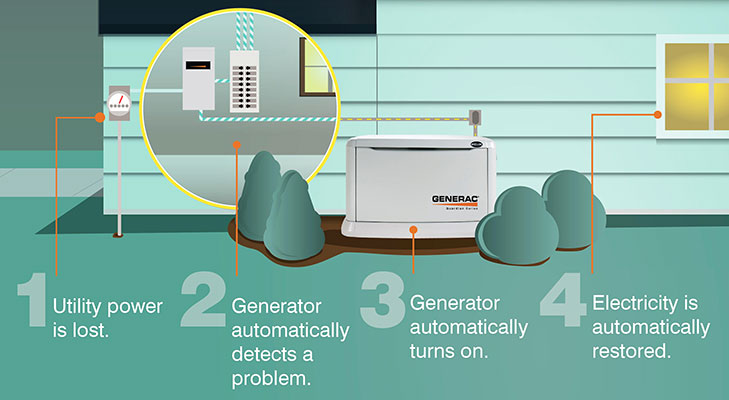
How Do Standby Generators Work?
A home standby generator has two parts: the generator unit and an automatic transfer switch. The two work in tandem to ensure your home gets power in a matter of seconds when a blackout occurs.
A professional installs the standby generator and the transfer switch to the home’s existing electrical wiring. It is always ready and works automatically if there is a power loss. It senses when the utility power stops flowing to the home’s system. Within seconds, the automatic switch transfers the home’s selected circuits and home appliances to the generator. Once the backup generator senses the main power is back on, your home is automatically transferred to the utility main power. Then the generator is shut down until when it is needed again.
Benefits of a Standby Generator
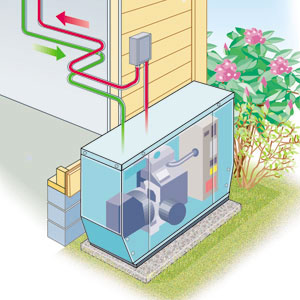
- Reduced noise for better operation. Most standby generators use new technologies that muffle sound to residential-friendly levels.
- It allows for extended maintenance gap. Unlike portable generators, you can stay longer periods between maintenance.
- Home standby generators are more fuel-efficient and have better fuel consumption. They have higher quality automotive-style engines that are more reliable and efficient.
- Standby generators generally use a liquid based cooling to handle the longer outage periods. It features A/C shedding and load management options for better efficiency.
- A great solution to back up the entire home. You can use your sensitive devices and high wattage essential appliances like air conditioners alongside your computer and standard equipment.
- If you live in an area of extreme weather conditions, inclement weather, extreme temperatures, or other natural disasters where power failure is more frequent. Home generators will provide an uninterrupted power supply for your essential home appliances.
What’s the Difference Between Portable and Standby Generators?
Portable generators keep vital appliances running during a blackout. Traditional portable generators also offer mobile power for a job site or a campsite. They are designed for short-term use and have to be switched on manually as they have no automatic switch. The connection is done manually using power cords, which are then switched off when the portable generator is no longer needed. These portable generators are intended for portable backup use. They require regular maintenance and tests to ensure they are ready for an outage.
Standby generators, on the other hand, are a more permanent solution to outages. They connect automatically in case of a blackout. Their price point is usually a bit higher. However, they come with many advantages. For starter, home standby generators run a weekly test to check that they will respond well to an outage. These whole house generators have a design to run for longer times using either liquid propane or natural gas line. Additionally, a whole house unit possesses more power and can handle larger loads, such as air conditioning systems, heating, security systems, and much more. They are also hard-wired into the electrical system so they can shut themselves off automatically. The generators return to standby mode automatically when no longer needed.
Learn more about the difference between portable and standby.
Understanding Whole House Generator Fuel Choices
To understand more about your generator’s fuel choices and the differences between these types. Below we explain some general information about the most common scenarios for the best-rated standby generators.
-
Diesel
Diesel is the traditional fuel for many appliances and backup power applications. One of the diesel’s benefits is that it has high thermal efficiency. So it will yield a low capital cost per kW in bigger applications. Also, diesel is often stored on-site, so you can use it in remote areas where natural gas is not a viable option due to a lack of infrastructure.
Because of reliability, most mission-critical applications like 911 and hospitals have diesel-fueled standby generators.
-
Natural Gas (NG)
For cost-effectiveness, perceptions of fuel reliability, durability, and also power density; gaseous fuels were avoided in the past. However, recent technological advancements have changed that. There are hardened seats and valves and also optimized air/fuel mixtures.
Natural gas-powered generators run like gasoline-powered ones. An internal combustion engine introduces a blend of air and fuel into the combustion chamber, and the piston compresses the mixture. Unlike gasoline or diesel-powered generators, natural gas generators can burn gaseous fuels rather than liquid ones. However, just like portable generators, the released exhaust fumes are dangerous and can lead to carbon monoxide poisoning. Hence, they are only operated outdoors where there is proper ventilation.
-
Liquid Propane (LP)
Liquid petroleum gas or liquefied petroleum gas (LP or LPG gas) are flammable mixtures of hydrocarbon gases. They are also simply known as propane or butane and used in heating appliances, vehicles, and cooking equipment. In reliable backup power systems, this can be in LP vapor and LP liquid configurations. LP vapor is preferred.
The spark ignited fuel runs in automotive engines adapted for its use. LP must be stored on-site just like diesel, and might, therefore, provide a great gaseous-fuel alternative to diesel for applications requiring on-site but with no fuel spoilage.

-
Bi-Fuel Systems
One way to alleviate problems when comparing on-site or utility-supplied fuel is to get a system that utilizes both fuels. Either simultaneously or one at a time. Bi-fuel and dual fuel generators fit these criteria.
Depending on availability, a dual-fuel system can operate on natural gas and LP vapor. A dual-fuel system will typically start on gas; if that supply is interrupted, it switches to on-site LP fuel. For larger systems, the bi-fuel configuration is quite popular. Bi-fuel generators burn both natural gas and diesel simultaneously in one engine. Starting up using diesel, which acts as pilot fuel, then slowly introduce gas in a process that the generator system can govern until it reaches the optimal fuel blend, usually 25% diesel fuel and 75% natural gas.
Learn more about how long can a generator run continuously, depending on each fuel type in our dedicated guide.
8 Important Questions About Whole House Generators
There are several factors to put into consideration when buying a whole home generator. Here are the top things to consider.
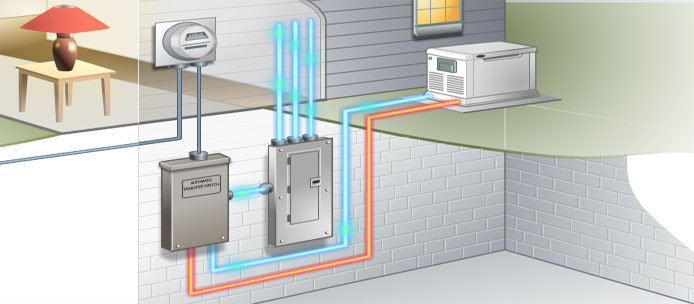
-
How to Pick the Right Size?
With generators, size matters. Proper sizing of your house generator is important to the success of any installation. It needs a good knowledge of electricity, power consumption, and load power requirements of your home’s appliances. When checking electrical loads, look at the manufacturer’s data plate on the equipment or machine to determine the starting amperage. This sizing guide will help you know what the ideal generator for your home is.
The top-rated standby generator size options are rated by the kilowatt. It is abbreviated as kW. It measures the total load or capacity that the generator can handle. For home-owners who want a good whole house generator power solution, a 20kW is an ideal choice. Bigger houses will do well with a 26-36kW range generator. However, if you are looking for the ultimate backup power system, then a 48kW generator can produce the power needed to run your home like a blackout never occurred.
-
Which Fuel Type?
The most common fuel types for standby generators are natural gas, propane, and diesel. Gasoline is not a good choice as it has a short shelf life. You may factor in costs as you choose the fuel type, as the cost difference can change depending on the size of the generator. Also, remember that the fuel type should be easily accessible to you. Diesel and propane offer an ‘on-site’ fuel source. But may also require a refill if there is an extended power outage. Local code requirements also dictate the fuel types available in your location.
-
Who will Install the System?
Usually, a qualified electrician, licensed electrician, or licensed plumber handles the installation. But the choice is up to the user. You may decide to go with a reputable company that has a history with home standby generators system installation. If you have no company in mind, then go with a referral.
-
Where will it be Located?
Standby generators should have a place that is easy to access for repair and maintenance. But also high enough to keep off water from reaching it. For rooftop and outdoor installations, ensure you abide by the local code requirements for minimum distance with building openings and combustible walls. In the case of indoor installations, comply with the requirements for ventilation, fuel supply, exhaust ducting, and also proximity to any combustible materials. Generally, the rule is that the generator should be located as close as possible to the fuel source and transfer switch. This brings us to the next factor to consider – the type of transfer switch.
-
Which Type of Transfer Switch?
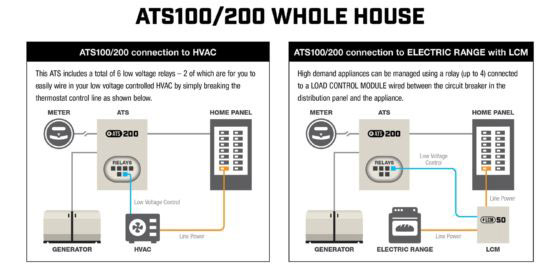
Transfer switches for emergency house generators are often automatically controlled. On the other hand, manual transfer switches can be used for some systems if they are preferred. But this lack of automation does not come with any cost-saving. The size of the transfer switch (based on amperage rating) and the location where it will be installed will be determined by your electrician. And it may also depend on whether the generator serves the whole house or just emergency power loads.
If the system is made to carry the whole house, the transfer switch may need to be rated ‘service entrance’. So it can incorporate a utility disconnect within the transfer switch cabinet. For commercial or industrial applications; there are other switches available such as bypass isolation, closed transition, and programmed transition. Check our post to learn more about the safest options for connecting a generator to your home.
-
What is the Warranty Duration?
This is very important as with the purchase of other electrical equipment. The standard warranty for generators runs from one to five years, depending on the type of generator. While a home generator may have a warranty ranging from one to five years, an industrial one will offer some optional upgrades. Understand the warranty duration and the type of coverage for your standby system. And also ask for upgrade costs if you need better coverage.
-
Who will Maintain the System?
Just like all major motors, a generator needs proper maintenance to ensure it runs smoothly. Thus, covering you in case of power outages. Generators tend to be neglected for long periods between blackouts, which can result in equipment failure when you need them. Get your equipment on a maintenance program or do it yourself for reliable operation. Note that some of the best whole house generator units in this guide runs weekly self diagnosis tests to make it easier for the owner.
-
Is it Residential Friendly?
A generator can be an excellent investment that brings so much to your home, including some unpleasant qualities such as noise. You do not want a machine that sounds like a Subaru engine running in your home. Check the decibel levels for quiet operation to ensure that the generator muffler is of good quality. Also, depending on your local building codes or building permits, you may have noise restrictions according to your local codes.
Bottom Line
When it comes to powering your home, having the best standby generator is of paramount importance. This whole house generator guide should provide you with a rough idea of what to look for when purchasing one. We have also included all the vital information that you should consider when getting the best whole house generator for your home. We hope you liked this article and welcome feedback from you. We’d love to know what you liked most about our home standby generator reviews. By now, you know what to look for in the best home generators most suitable for your space. You can be confident that your home is protected from power outages.

